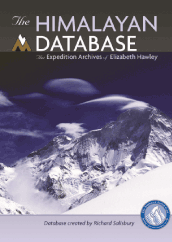 Book cover of The Himalayan Database Book cover of The Himalayan Database | |
| Author | Elizabeth Hawley, Richard Sailsbury |
|---|---|
| Language | English |
| Subject | Mountaineering |
| Genre | Database |
| Publisher | |
| Publication date | 1 October 2004 |
| Media type | Multimedia CD |
| Pages | 80 |
| ISBN | 978-0930410995 |
| Website | The Himalayan Database |
The Himalayan Database: The Expedition Archives of Elizabeth Hawley is a large digital and published record of mountaineering in the Nepalese Himalayas since 1903 (i.e. it does not include the Pakistan Himalaya peaks such as K2 and Nanga Parbat etc.), maintained by Richard Salisbury who digitised the records.
Background
The Himalayan Database (HDB), was developed and maintained by Elizabeth Hawley, who remained involved up to her death in 2018. It was published as a CD and an 80-page paperback up until 2017. From 2017 onwards, records of expeditions, their members have been searchable online, or available as a complete downloadable database. It fills in for the absence of officially maintained records. It has been published by the American Alpine Club.
As well as being an important repository for climbing statistics on Himalayan mountains, the database also became known for its decisions to disregard or dispute various climbs. Notable cases was the decision not to record a 1990 ascent of Cho Oyu by British climber Alan Hinkes, which put a question-mark over Hinkes' claim to have summited all 14 eight-thousanders; and the 1997 ascent of Lhotse by Italian climbers Fausto De Stefani and Sergio Martini which forced Sergio Martini to reclimb Lhotse in 2000 to verify he had climbed all 14 eight-thousanders (De Stefani decided not to re-climb).
Bibliography
- Salisbury, Richard; Hawley, Elizabeth (October 2004). The Himalayan Database: The Expedition Archives of Elizabeth Hawley. American Alpine Club. ISBN 978-0930410995.
- Salisbury, Richard; Hawley, Elizabeth (March 2012). The Himalaya by Numbers: A Statistical Analysis of Mountaineering in the Nepal Himalaya. Mountaineers Books. ISBN 978-9937506649.
- McDonald, Bernadette; Hillary, Sir Edmund (October 2012). Keeper of the Mountains. RMB. ISBN 978-1927330159.
See also
References
- Firth, Paul G; Zheng, Hui; Windsor, Jeremy S; Sutherland, Andrew I; Imray, Christopher H; Moore, G W K; Semple, John L; Roach, Robert C; Salisbury, Richard A (2008-12-11). "Mortality on Mount Everest, 1921-2006: descriptive study". The BMJ. 337: a2654. doi:10.1136/bmj.a2654. ISSN 0959-8138. PMC 2602730. PMID 19074222.
- "Nepal honours chronicler of Himalayan mountaineering Elizabeth Hawley". The Independent. 2014-08-20. Archived from the original on 2022-06-18. Retrieved 2017-02-16.
- Desai, Shail (2016-05-28). "Deaths on Everest: Man-made disaster on the route to personal glory". Retrieved 2017-02-16.
- ^ REI. "The Himalayan Database CD-Rom: The Expedition Archives of Elizabeth Hawley". REI. Retrieved 2017-02-16.
- "Everest 2013: Interview with Richard Salisbury, the Man Behind the Everest Summit Numbers". The Blog on alanarnette.com. 2013-02-18. Retrieved 2017-02-16.
- "Does Everest Have a Drug Problem? | VICE Sports". VICE Sports. Retrieved 2017-02-16.
- Westhoff, John L.; Koepsell, Thomas D.; Littell, Christopher T. (2012-06-13). "Effects of experience and commercialisation on survival in Himalayan mountaineering: retrospective cohort study". BMJ. 344: e3782. doi:10.1136/bmj.e3782. ISSN 1756-1833. PMC 3374484. PMID 22695902.
- If a mountaineer wants worldwide recognition that they have reached the summit of some of the most formidable mountains in the world, they will need to get the approval of Elizabeth Hawley."Elizabeth Hawley, unrivalled Himalayan record keeper". BBC News. 29 August 2010.
- "Elizabeth Hawley, Who Chronicled Everest Treks, Dies at 94". New York Times. 26 January 2018.
- Elizabeth Hawley (2014). "Seasonal Stories for the Nepalese Himalaya 1985-2014" (PDF). The Himalayan Database. p. 347.
But his claim to have now climbed all 8000ers is open to question. In April 1990 he and others reached the summit plateau of Cho Oyu. It was misty so they could not see well; nine years later Hinkes said he had "wandered around for a while" in the summit area but could see very little and eventually descended to join the others, one of whom said they had not reached the top.
- Elizabeth Hawley (2014). "Seasonal Stories for the Nepalese Himalaya 1985-2014" (PDF). The Himalayan Database. p. 274.
But a South Korean climber, who followed in their footprints on the crusted snow three days later in clearer weather, did not consider that they actually gained the top. While Martini and De Stefani indicated they were perhaps only a few meters below it, Park Young-Seok claimed that their footprints stopped well before the top, perhaps 30 meters below a small fore-summit and 150 vertical meters below the highest summit. Now in 2000 Martini was back again, and this time he definitely summited Lhotse.
External links
- The Himalayan Database, main website for the database
- Graphical Interface for The Himalayan Database